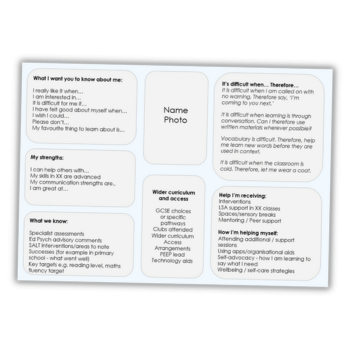Curriculum design – Why it can and should be a team effort

What does it take to successfully involve both teachers and leaders in the process of curriculum design? Martin Robinson has some ideas…

Curriculum design can be undertaken at any speed, by small or larger groups of people working together on its entirety, or on specific components only.
However, subject departments come in many different sizes – from some that are sprawling, down to others that are run by one person on their own – which will in turn affect who has direct input into the curriculum design process.
Happy medium
There’s a longstanding divide between two popular conceptions of curriculum development. At one end are the scripted curricula that many people seem fearful of – see the recent debates around Oak National Academy – due to a suspicion that there will always be others telling teachers what to do.
At the opposite end of the spectrum is complete anarchy – everyone doing their own thing, with teachers enjoying near total creative freedom, but with little thought given as to how what each teacher is doing, or how a child’s overall experience of their schooling, ultimately connects together.
In my book Curriculum Revolutions, I make the case for trying to find a happy medium (albeit one leaning slightly more towards the ‘planned and scripted’ end) and finding within that a place where people can see the need for joined-up thinking, while also recognising the creative aspects of what it is to be a teacher.
I believe that over a period of time, it’s entirely possible for schools to create their own curriculum collectively, in a way that ensures buy-in. That way, teachers feel that it’s their curriculum, rather than one ultimately belonging to someone else.
Making connections
Many teachers can happily pick up a textbook and simply go with it. Others may opt to use only certain parts, often in conjunction with other materials and resources. And then there are the teachers who prefer not to use textbooks at all, as they feel their way of tackling a subject is the right way.
Curriculum development involves navigating a path through these different attitudes, and highlighting the need for teachers to think about how what they do connects to the work of their colleagues.
When it comes to deciding on which staff can and should contribute to curriculum development, the first stop will usually be your subject departments. The members of those departments will typically form the ‘curriculum design team’ for a given subject, but occasionally a single department may be so large that it’s necessary to whittle down the number of team members.
What schools should avoid is appointing a specific teacher to ‘do’ Y7, Y8 or KS3, and allowing them to become ‘the’ person in charge of that particular curriculum area on their own. Without any connections to others, there’s a strong likelihood that they’ll simply go with what’s been done before, with only minor changes.
Prior explanations
Teachers can sometimes reject or dismiss material that pupils have been taught previously. As a teacher, parent and latterly observer of teachers, it’s incredible to me how often one sees a new teacher take over a class and dismantle lesson content that has been structured quite carefully over time by a teacher before them.
We can mitigate this by including prior explanations in our teaching and curriculums that are fundamental to the subject in question – explanations that pertain to the make-up of atoms, for example, or what a sentence is.
Teachers who already possess that fundamental knowledge may be unable to appreciate just how digestible and easily internalised that knowledge can be when broken down into elements that are explained and repeatedly re-explained.
For pupils who are moderately well-informed or well-read, a lack of prior explanations may present less of a problem. For those who hang on their teacher’s every word, however, the security of having those explanations will be far preferable to having what they know thrown apart whenever a new teacher takes over.
Gentle evolution
It’s also common to encounter the opposite problem, where a curriculum becomes ‘stuck’ through inertia. This is often down to resourcing, and schools simply lacking the money or time to overhaul their curriculums as they’d like to.
That said, the book might be titled Curriculum Revolutions, but I hope to make it clear that curriculum development doesn’t have to be a full-blooded revolution from day 1. It can be an evolutionary process, even a very gentle one.
For starters, it’s perfectly okay to feel that if something isn’t broken, it doesn’t need to be fixed. At the same time, however, there will always be elements of churn by dint of the fact that knowledge itself changes. Peking became Beijing. Books get removed from the exam syllabus. Sometimes, a syllabus switching from one book to another can even alter what you need to teach before you get to that book.
That’s why it’s important to always consider the knowledge that comes before, at an earlier stage, and the extent to which that might need updating depending on decisions made at a later stage of the curriculum.
New scientific discoveries are always being made. A subject like art will always see the emergence of new ideas, approaches and techniques. Curriculum development is a political process as well, of course – things change. You can’t set them in stone.
Robust collegiality
Schools also need to maintain an atmosphere in which people can have robust conversations. By that, I don’t mean confrontational exchanges that verge on the point of fighting, but rather conversations that are strong enough to bear disagreement.
That extends to the relationships between teachers and leaders. If we’re frightened of our line manager, we’re going to try and guess what they want us to do. We therefore remain silent until we receive that message and feel secure in it, whereupon we’ll nod our heads in agreement with whatever their plans might be.
A compliance culture can then take hold, where people stay quiet, nod things through and try not to rock the boat. Or, indeed, you can have the complete opposite – a culture where everyone’s out of control and feels emboldened to behave in non-collegiate ways.
Instead, I’d like to see schools engender a type of ‘robust collegiality’, where the disagreements individuals have with each other don’t undermine their collective efforts, but actually strengthen them. It’s worth remembering that people are often willing and able to compromise. They might not always get their way, but they will always appreciate being listened to.
The trouble senior leaders can have is that they don’t understand every subject, and therefore can’t work out whether the curriculum they’re using is actually good. A former maths teacher might easily see and understand a school’s proposed maths curriculum – but what if they’re shown a drama curriculum?
That’s why it’s important to maintain an element of trust, by encouraging a positive working culture and establishing curriculum narratives. If fellow teachers – or even pupils – can describe to leaders what a curriculum is, demonstrate its consistency and explain its narrative, that should give those leaders a fairly qualitative idea as to whether a curriculum is any good or not.
Martin Robinson is an education consultant specialising in curriculum design, teaching methodology and culture, having previously worked in East London state schools as a teacher, head of department, head of faculty, advanced skills teacher and school leader
His latest book, Curriculum Revolutions: A Practical Guide to Enhancing What You Teach, is available now (£15, John Catt)








